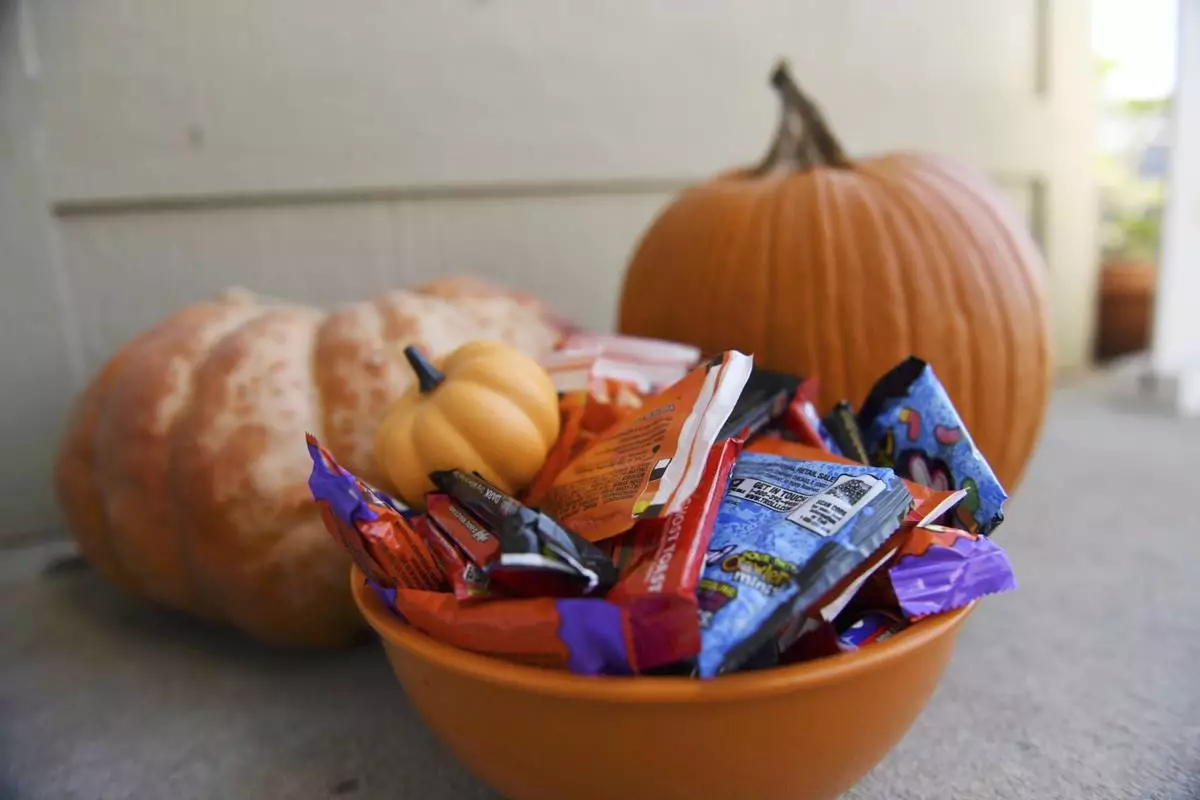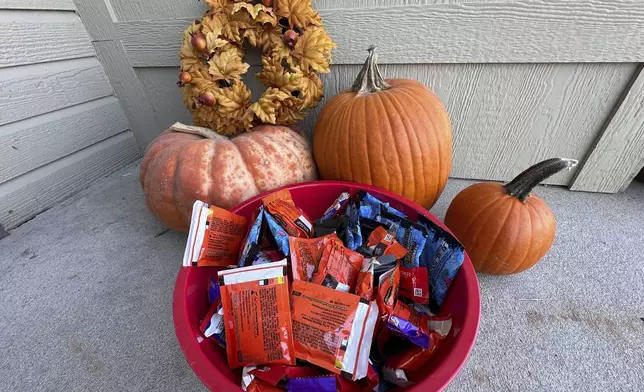ST. LOUIS (AP) — Many states have laws designed to keep children away from convicted sexual offenders on Halloween night, such as curfews for those on offender registries and requirements to keep their porch lights off.
But a Missouri law mandating a sign at the offender's home was a step too far, a judge ruled.
Click to Gallery
Halloween candy and pumpkins sit outside of a home Friday, Oct. 11, 2024, in St. Joseph, Mo. (AP Photo/Nick Ingram)
Halloween candy and pumpkins sit outside of a home Friday, Oct. 11, 2024, in St. Joseph, Mo. (AP Photo/Nick Ingram)
The Thomas F. Eagleton United States Courthouse is shown Thursday, Oct. 10, 2024, in St. Louis. (AP Photo/Jeff Roberson)
Thomas F. Eagleton United States Courthouse is shown Thursday, Oct. 10, 2024, in St. Louis. (AP Photo/Jeff Roberson)
The Thomas F. Eagleton United States Courthouse is shown Thursday, Oct. 10, 2024, in St. Louis. (AP Photo/Jeff Roberson)
A 2008 law required registered offenders in Missouri to post signs on Oct. 31 that read “No candy or treats at this residence.” U.S. District Judge John Ross ruled this month that the provision violated the First Amendment by forcing “compelled speech," depriving those on the registry "of their freedom to speak in their own words or to not speak at all.”
The ruling lets stand other provisions of the Missouri law that require people on the registry on Halloween to remain inside their home from 5 p.m. to 10:30 p.m. and to leave their outdoor lights off.
The Missouri sign law is unique among states, but some cities and counties have tried similar laws that were either struck down in court or withdrawn as part of lawsuit settlements.
Ross' ruling on the Missouri sign law drew a mixed response. Some said extraordinary steps are necessary on a night when children flood the streets and often knock on the doors of strangers. Others said the sign law was unnecessarily cruel — and even counterproductive.
“I feel like it’s a setback and another example of predators’ rights kind of trumping those of their victims,” said Tara Bishop, a 40-year-old mother of four from southwestern Missouri who operates a Facebook page called Child Predators Exposed with more than 10,000 followers.
But an extensive examination of crime data published in 2009 in the Sexual Abuse journal found no increased risk of sexual abuse of children on Halloween. Experts say the vast majority of child sexual abuse crimes involve someone known by the victim or the child's family, and not strangers.
Janice Bellucci, the lawyer for the Missouri man who challenged the law, said that for those forced to place the sign, the damage is long-lasting.
“It’s not just stigmatizing you that one day, it stigmatizes you for the rest of your life, as long as you live there," said Bellucci, who is part of the California-based Alliance for Constitutional Sex Offense Laws.
The lawsuit was filed on behalf of Thomas L. Sanderson of Hazelwood, Missouri, a St. Louis suburb. He was convicted of second-degree sodomy in 2006 after a 16-year-old family friend accused him of sexually touching her. Sanderson, who has maintained his innocence, was sentenced to two years in prison and required to register as a sexual offender for 25 years.
The Missouri Halloween law was adopted two years later. It is unclear how many of the state's approximately 26,000 convicted sexual offenders have been charged for violating the statute, or how stringent enforcement has been. The law doesn't say where the sign must be placed. People on the registry are responsible for making their own signs.
The lawsuit said Sanderson asked police if he was subject to the law because his conviction happened before its passage. He said he was told he was not, so he continued to host Halloween parties complete with animatronic figures, lights, a bonfire, music and candy, the lawsuit said.
But the lawsuit said that on Halloween night 2022, police arrived at Sanderson's home. No sign was posted, and he was arrested. He pleaded guilty to a misdemeanor for violating the Halloween statute and received probation. He sued last year.
Missouri Attorney General Andrew Bailey's office, in court filings, wrote that the state is duty-bound to protect children who can't make adequate decisions on their own. Bailey's office said an appeal is planned.
“I want Missouri to be the safest state in the nation for children. That includes on Halloween," Bailey, a Republican, said in a statement.
Alison Feigh, director of Jacob Wetterling Resource Center at Zero Abuse Project, which focuses on helping institutions prevent, recognize and respond to child sexual abuse, said most assaults happen after offenders build relationships with victims and their families. Tactics like signs are not helpful in keeping children safe, she said in an email.
“These public signs may give a false sense of security to families while not actually preventing child abuse,” Feigh said.
Other Halloween sign laws also have faced setbacks.
In Georgia, the Butts County Sheriff's Office was sued in 2019, with people on registries alleging that authorities trespassed onto their properties to post signs that caused humiliation and anxiety. The signs read: “WARNING! NO TRICK-OR-TREATING AT THIS ADDRESS!! A COMMUNITY SAFETY MESSAGE FROM BUTTS COUNTY SHERIFF GARY LONG."
A federal appeals court panel in 2022 said the signage violated the First Amendment.
In California, Simi Valley required Halloween signs in the yards of registered sexual offenders until reaching a 2013 settlement in a lawsuit filed by the Alliance for Constitutional Sex Offense Laws on behalf of five offenders.
In January, the alliance filed suit after the sheriff's office in Marion County, Arkansas, created and posted signs and placed them in the yards of those on the registry. The signs read: "Sorry! No Trick or Treat.” The sheriff's office later agreed to stop posting or requiring the signs.

Halloween candy and pumpkins sit outside of a home Friday, Oct. 11, 2024, in St. Joseph, Mo. (AP Photo/Nick Ingram)

Halloween candy and pumpkins sit outside of a home Friday, Oct. 11, 2024, in St. Joseph, Mo. (AP Photo/Nick Ingram)

The Thomas F. Eagleton United States Courthouse is shown Thursday, Oct. 10, 2024, in St. Louis. (AP Photo/Jeff Roberson)

Thomas F. Eagleton United States Courthouse is shown Thursday, Oct. 10, 2024, in St. Louis. (AP Photo/Jeff Roberson)

The Thomas F. Eagleton United States Courthouse is shown Thursday, Oct. 10, 2024, in St. Louis. (AP Photo/Jeff Roberson)
MAGDEBURG, Germany (AP) — Germans on Saturday mourned the victims and their shaken sense of security after a Saudi doctor intentionally drove into a Christmas market teeming with holiday shoppers, killing at least five people, including a small child, and wounding at least 200 others.
Authorities arrested a 50-year-old man at the site of the attack in Magdeburg on Friday evening and took him into custody for questioning. He has lived in Germany since 2006, practicing medicine in Bernburg, about 40 kilometers (25 miles) south of Magdeburg. officials said.
The state governor, Reiner Haseloff, told reporters that the death toll rose to five from a previous figure of two and that more than 200 people in total were injured.
Chancellor Olaf Scholz said that nearly 40 of them "are so seriously injured that we must be very worried about them.”
“There is no more peaceful and cheerful place than a Christmas market,” Scholz said. “What a terrible act it is to injure and kill so many people there with such brutality.”
Neurosurgeon Mahmoud Elenbaby said some 80 patients were brought to Magdeburg’s university hospital on Friday night.
“We managed to stabilize most of them, but many are still in intensive care, and some are also in critical condition,” Elenbaby told The Associated Press as he dashed into the hospital cafeteria to buy himself a cola.
Several German media outlets identified the suspect as Taleb A., withholding his last name in line with privacy laws, and reported that he was a specialist in psychiatry and psychotherapy.
Mourners lit candles and placed flowers outside a church near the market on the cold and gloomy day. Several people stopped and cried. A Berlin church choir whose members witnessed a previous Christmas market attack in 2016 sang Amazing Grace, a hymn about God's mercy, offering their prayers and solidarity with the victims.
There were still no answers Saturday as to what motivated the man to drive his black BMW into a crowd in the eastern German city.
Describing himself as a former Muslim, the suspect shared dozens of tweets and retweets daily focusing on anti-Islam themes, criticizing the religion and congratulating Muslims who left the faith.
He also accused German authorities of failing to do enough to combat what he said was the “Islamism of Europe.”
The violence shocked Germany and the city, bringing its mayor to the verge of tears and marring a festive event that’s part of a centuries-old German tradition. It prompted several other German towns to cancel their weekend Christmas markets as a precaution and out of solidarity with Magdeburg’s loss. Berlin kept its markets open but has increased its police presence at them.
Germany has suffered a string of extremist attacks in recent years, including a knife attack that killed three people and wounded eight at a festival in the western city of Solingen in August.
Magdeburg is a city of about 240,000 people, west of Berlin, that serves as Saxony-Anhalt’s capital. Friday’s attack came eight years after an Islamic extremist drove a truck into a crowded Christmas market in Berlin, killing 13 people and injuring many others. The attacker was killed days later in a shootout in Italy.
Chancellor Scholz and Interior Minister Nancy Faeser traveled to Magdeburg on Saturday, and a memorial service is to take place in the city cathedral in the evening. Faeser ordered flags lowered to half-staff at federal buildings across the country.
Verified bystander footage distributed by the German news agency dpa showed the suspect’s arrest at a tram stop in the middle of the road. A nearby police officer pointing a handgun at the man shouted at him as he lay prone, his head arched up slightly. Other officers swarmed around the suspect and took him into custody.
Thi Linh Chi Nguyen, a 34-year-old manicurist from Vietnam whose salon is located in a mall across from the Christmas market, was on the phone during a break when she heard loud bangs and thought at first they were fireworks. She then saw a car drive through the market at high speed. People screamed and a child was thrown into the air by the car.
Shaking as she described the horror of what she witnessed, she recalled seeing the car bursting out of the market and turning right onto Ernst-Reuter-Allee street and then coming to a standstill at the tram stop where the suspect was arrested.
The number of injured people was overwhelming.
“My husband and I helped them for two hours. He ran back home and grabbed as many blankets as he could find because they didn’t have enough to cover the injured people. And it was so cold," she said.
The market itself was still cordoned off Saturday with red-and-white tape and police vans every 50 meters (yards). Police with machine pistols guarded every entry to the market. Some thermal security blankets still lay on the street.
Christmas markets are a German holiday tradition cherished since the Middle Ages, now successfully exported to much of the Western world.
Moulson reported from Berlin and Gera from Warsaw, Poland.

A blanket lies on a Christmas Market, where a car drove into a crowd on Friday evening, in Magdeburg, Germany, Saturday, Dec. 21, 2024. (AP Photo/Michael Probst)

Policemen guard a Christmas Market, where a car drove into a crowd on Friday evening, in Magdeburg, Germany, Saturday, Dec. 21, 2024. (AP Photo/Michael Probst)

Policemen guard a Christmas Market, where a car drove into a crowd on Friday evening, in Magdeburg, Germany, Saturday, Dec. 21, 2024. (AP Photo/Michael Probst)

German Chancellor Olaf Scholz, centre, speaks at a Christmas Market, where a car drove into a crowd on Friday evening, in Magdeburg, Germany, Saturday, Dec. 21, 2024. (AP Photo/Michael Probst)

Citizens pay tribute to deaths outside St. John's Church near a Christmas Market, where a car drove into a crowd on Friday evening, in Magdeburg, Germany, Saturday, Dec. 21, 2024. (AP Photo/Ebrahim Noorozi)

Citizens pay tribute and cry for deaths outside St. John's Church near a Christmas Market, where a car drove into a crowd on Friday evening, in Magdeburg, Germany, Saturday, Dec. 21, 2024. (AP Photo/Ebrahim Noorozi)

A policeman, right, stands on a Christmas Market, where a car drove into a crowd on Friday evening, in Magdeburg, Germany, Saturday, Dec. 21, 2024. (AP Photo/Michael Probst)

Citizens pay tribute to deaths outside St. John's Church near a Christmas Market, where a car drove into a crowd on Friday evening, in Magdeburg, Germany, Saturday, Dec. 21, 2024. (AP Photo/Ebrahim Noorozi)

Two firefighters walk through a cordoned-off area near a Christmas Market, after a car drove into a crowd in Magdeburg, Germany, Saturday, Dec. 21, 2024. (AP Photo/Ebrahim Noroozi)

A damaged car sits with its doors open after a driver plowed into a busy Christmas market in Magdeburg, Germany, early Saturday, Dec. 21, 2024. (Hendrik Schmidt/dpa via AP)

Police stand at a Christmas market in Magdeburg, Germany, early Saturday, Dec. 21, 2024, after a driver plowed into a group of people at the market late Friday. (Hendrik Schmidt/dpa via AP)

Police stand at a Christmas market in Magdeburg, Germany, early Saturday, Dec. 21, 2024, after a driver plowed into a group of people at the market late Friday. (Hendrik Schmidt/dpa via AP)

A damaged car sits with its doors open after a driver plowed into a busy Christmas market in Magdeburg, Germany, early Saturday, Dec. 21, 2024. (Hendrik Schmidt/dpa via AP)

Police officers and police emergency vehicles are seen at the Christmas market in Magdeburg after a driver plowed into a busy Christmas market in Magdeburg, Germany, Saturday, Dec. 21, 2024. (Matthias Bein/dpa via AP)

Security guards stand in front of a cordoned-off Christmas Market after a car crashed into a crowd of people, in Magdeburg, Germany, Saturday early morning, Dec. 21, 2024. (AP Photo/Ebrahim Noroozi)

A barrier tape and police vehicles are seen in front of the entrance to the Christmas market in Magdeburg after a driver plowed into a busy Christmas market in Magdeburg, Germany, Saturday, Dec. 21, 2024. (Sebastian Kahnert/dpa via AP)

The car that was crashed into a crowd of people at the Magdeburg Christmas market is seen following the attack in Magdeburg, Germany, Saturday early morning, Dec. 21, 2024. (AP Photo/Ebrahim Noroozi)

People mourn in front of St. John's Church for the victims of Friday's attack at the Christmas market in Magdeburg, Germany, Saturday, Dec. 21, 2024. (Matthias Bein/dpa via AP)

Police tape cordons-off a Christmas Market, where a car drove into a crowd on Friday evening, in Magdeburg, Germany, Saturday, Dec. 21, 2024. (AP Photo/Ebrahim Noroozi)

A police officer stands guard at at a cordoned-off area near a Christmas Market, where a car drove into a crowd on Friday evening, in Magdeburg, Germany, Saturday, Dec. 21, 2024. (AP Photo/Ebrahim Noroozi)

Police officers patrol a cordoned-off area at a Christmas Market, where a car drove into a crowd on Friday evening, in Magdeburg, Germany, Saturday, Dec. 21, 2024. (AP Photo/Ebrahim Noroozi)

Security guards stand in front of a cordoned-off Christmas Market after a car crashed into a crowd of people, in Magdeburg, Germany, Saturday, Dec. 21, 2024. (AP Photo/Ebrahim Noroozi)

Emergency services work in a cordoned-off area near a Christmas Market, after a car drove into a crowd in Magdeburg, Germany, Saturday, Dec. 21, 2024. (AP Photo/Ebrahim Noroozi)

Emergency services work in a cordoned-off area near a Christmas Market, after a car drove into a crowd in Magdeburg, Germany, Friday, Dec. 20, 2024. (AP Photo/Ebrahim Noroozi)

Emergency services work in a cordoned-off area near a Christmas Market, after a car drove into a crowd in Magdeburg, Germany, Friday, Dec. 20, 2024. (AP Photo/Ebrahim Noroozi)

Reiner Haseloff, Minister President of Saxony-Anhalt, center, is flanked by Tamara Zieschang, Minister of the Interior and Sport of Saxony-Anhalt, left, and Simone Borris, Mayor of the City of Magdeburg, at a press conference after a car plowed into a busy outdoor Christmas market in Magdeburg, Germany Friday, Dec. 20, 2024. (Hendrik Schmidt/dpa via AP)

Emergency services work in a cordoned-off area near a Christmas Market, after a car drove into a crowd in Magdeburg, Germany, Friday, Dec. 20, 2024. (AP Photo/Ebrahim Noroozi)

Emergency services work in a cordoned-off area near a Christmas Market, after a car drove into a crowd in Magdeburg, Germany, Friday, Dec. 20, 2024. (AP Photo/Ebrahim Noroozi)

Emergency services work in a cordoned-off area near a Christmas Market, after a car drove into a crowd in Magdeburg, Germany, Friday, Dec. 20, 2024. (AP Photo/Ebrahim Noroozi)

A police officer guards at a blocked road near a Christmas Market, after an incident in Magdeburg, Germany, Friday, Dec. 20, 2024. (AP Photo/Ebrahim Noroozi)

Emergency services attend an incident at the Christmas market in Magdeburg, Germany, Friday Dec. 20, 2024. (Dörthe Hein/dpa via AP)

Emergency services attend an incident at the Christmas market in Magdeburg, Germany, Friday Dec. 20, 2024. (Heiko Rebsch/dpa via AP)

Emergency services attend an incident at the Christmas market in Magdeburg, Germany, Friday Dec. 20, 2024. (Heiko Rebsch/dpa via AP)

A police officer guards at a cordoned-off area near a Christmas Market after an incident in Magdeburg, Germany, Friday, Dec. 20, 2024. (AP Photo/Ebrahim Noroozi)

In this screen grab image from video, special police forces attend an incident at the Christmas market in Magdeburg, Germany, Friday Dec. 20, 2024. (Thomas Schulz/dpa via AP)

Reiner Haseloff (M, CDU), Minister President of Saxony-Anhalt, makes a statement after an incident at the Christmas market in Magdeburg, Germany, Friday Dec. 20, 2024. (Heiko Rebsch/dpa via AP)

A police officer speaks with a man at a cordoned-off area near a Christmas Market after an incident in Magdeburg, Germany, Friday, Dec. 20, 2024. (AP Photo/Ebrahim Noroozi)

A policeman is seen at the Christmas market where an incident happened in Magdeburg, Germany, Friday Dec. 20, 2024. (Heiko Rebsch/dpa via AP)

A firefighter walks through a cordoned-off area near a Christmas Market, after a car drove into a crowd in Magdeburg, Germany, Saturday, Dec. 21, 2024. (AP Photo/Ebrahim Noroozi)

Emergency services work in a cordoned-off area near a Christmas Market, after an incident in Magdeburg, Germany, Friday, Dec. 20, 2024. (AP Photo/Ebrahim Noroozi)

A view of the cordoned-off Christmas market after an incident in Magdeburg, Germany, Friday Dec. 20, 2024. (Heiko Rebsch/dpa via AP)

A police officer guards at a blocked road near a Christmas market after an incident in Magdeburg, Germany, Friday, Dec. 20, 2024. (AP Photo/Ebrahim Noroozi)

The car that was crashed into a crowd of people at the Magdeburg Christmas market is seen following the attack in Magdeburg, Germany, Saturday early morning, Dec. 21, 2024. (AP Photo/Ebrahim Noroozi)

Security guards stand in front of a cordoned-off Christmas Market after a car crashed into a crowd of people, in Magdeburg, Germany, Saturday early morning, Dec. 21, 2024. (AP Photo/Ebrahim Noroozi)

Security guards stand in front of a cordoned-off Christmas Market after a car crashed into a crowd of people, in Magdeburg, Germany, Saturday early morning, Dec. 21, 2024. (AP Photo/Ebrahim Noroozi)

The car that was crashed into a crowd of people at the Magdeburg Christmas market is seen following the attack in Magdeburg, Germany, Saturday early morning, Dec. 21, 2024. (AP Photo/Ebrahim Noroozi)

Forensics work on a damaged car sitting with its doors open after a driver plowed into a busy Christmas market in Magdeburg, Germany, early Saturday, Dec. 21, 2024. (Hendrik Schmidt/dpa via AP)


































































